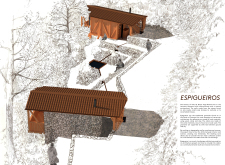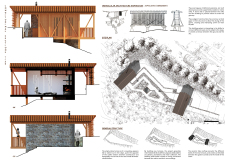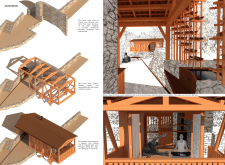5 key facts about this project
The Vale de Moses Yoga Retreat is located in a beautiful region of Portugal, designed as a place for wellness and relaxation. It draws inspiration from local architectural traditions, particularly the traditional granaries known as Espigueiros. The design focuses on connecting the buildings with the surrounding landscape, creating spaces that encourage calmness and mindfulness. By taking advantage of the natural topography, the retreat allows indoor and outdoor areas to blend together, offering visitors a unique experience.
Design Concept
The design centers on integrating nature in a way that feels natural and inviting. Using the land's natural slope, it creates terraces that serve various purposes—some for growing plants and others for resting or gathering. This thoughtful arrangement promotes a sense of harmony with the environment. Visitors can feel at one with nature, making the experience truly enriching.
Materiality
The use of local stone is a key characteristic of the retreat's design. This choice helps the buildings match their surroundings while ensuring structural strength. Sourcing materials from the site not only supports local resources but also reduces the need for transportation, making it more sustainable. This connection to the land adds to the overall identity of the retreat, grounding it in the region's culture.
Elevated Structures
Incorporating elevated granaries into the design adds a practical and aesthetic dimension. These structures are raised on stilts, which prevents pests from entering and creates an interesting relationship with the ground below. The gaps in the walls allow fresh air and light to enter, creating a lively atmosphere inside. This thoughtful design enhances visual interest and encourages occupants to appreciate their surroundings.
Sustainability Elements
A rainwater collection system is part of the retreat, showcasing a commitment to environmentally friendly practices. This system links the buildings to the landscape and ensures that water management is efficient. The design also takes advantage of different levels in the landscape to create spaces for movement and social interaction. This approach not only fosters community among visitors but also enhances the retreat's sustainability.
One notable detail is how the stone walls interact with the contours of the land, flowing up and down with the terrain. This creates a connection between what is built and what is natural, allowing the retreat to become a part of its environment.






















































